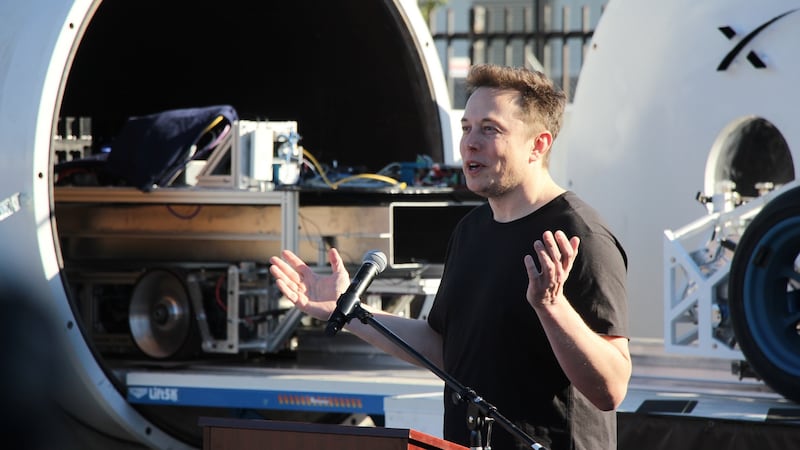In 1884, Irishman Frank Ebrington, a trainee engineer, became the fastest man in the world. He boarded an empty train at Kingstown (now Dún Laoghaire). Seventy-five seconds later, he had travelled 2.8km uphill to Dalkey, at an average speed of 135km/h. He was the sole occupant of a carriage on the world's first full-scale trial "atmospheric railway".
The railway was designed by the great engineer Isambard Kingdom Brunel. Brunel argued that placing a heavy steam engine in a fixed location beside a railway track, rather than actually moving along on top of it, would create cheaper, quieter and more efficient locomotion. Thus, five minutes before the scheduled departure time at Kingstown, an engineman at Dalkey would start a huge 75kW pumping engine. This evacuated the air in a 40cm diameter cast-iron pipe which ran down the middle of the track to Kingstown. The pipe had a narrow slot all along its top, sealed with leather, into which a piston attached to the passenger carriages was inserted. The piston, and its carriages, was then sucked along the pipe, offering passengers a quiet, smokeless high-speed alternative to a steam train.
There were a few problems. The pipe ended about 100m before the Dalkey platform, and the piston would explosively emerge like a cork from a champagne bottle. If the carriages were lightly loaded, they would overshoot the platform. If particularly heavily loaded, the carriages would slide to a halt before the platform. And rats ate the leather pipe seal, reducing suction pressure.
Hyperloop
Today, Elon Musk is proposing an alternative sealed pipe design for trains. His Hyperloop intercity system envisages passengers travelling at high speed not on top but inside sealed tubes, with air evacuated ahead of the train. Musk's Tesla and SpaceX jointly developed a conceptual design, which was subsequently published under open-source licensing. Several commercial teams across the world are now developing Hyperloop prototypes.
In June 2015, SpaceX announced it would build a 1.6km test Hyperloop tube at Hawthorne, in the Los Angeles suburbs. The facility is available for prototypes, including those submitted via an annual competition.

A private Irish team – Andrew Ashmore (a Carlow farmer with self-confessed tool-making skills), Tom Finnegan (chief executive of Fintos electric cars) and Conor Gray (engineering manager at Motolev) – entered the first Hyperloop competition in 2015. However, in mid-competition the rules changed to allow only student teams. Ashmore then immediately approached a number of Irish academics but there was little interest in becoming involved.
He attended the August 2017 student challenge in Hawthorne, meeting some of the international teams competing, and learned from a German team that the students involved had organised, and only then announced themselves de facto to their respective universities.
Inspired, Ashmore returned to Ireland, created a single-page advertisement, seeking interest in an Irish student entry to the July 2018 Hyperloop Challenge and posted the adverts on student noticeboards. A secretary at one university engineering department kindly agreed to notify all its first-year engineering students. Even more directly, Ashmore went from institution to institution and posted the advert on the back doors of toilet cubicles. Bravely, he even put some up in female cubicles, and survived a telling off by an understandably annoyed female academic in one institute of technology.
Éirloop
A kick-off meeting was held in a Dublin hotel in late September 2017. Students from DCU, DIT, IT Carlow, IT Tallaght, Maynooth University, TCD and UCD all attended. Thus the Éirloop team of 40 student engineers, physicists, computer scientists and designers was formed.
More than 700 entries were submitted worldwide to SpaceX’s 2018 challenge by December 2017, each with an outline design. From these, SpaceX has selected just 20 student teams to the challenge based on the quality of their proposals, including in particular safety. Only six are from Europe. We should all be very proud indeed that Éirloop made the cut.
The Éirloop team members are now building their prototype. They have to air-freight it to Los Angeles, together with a small representative team, for the July competition. Their prototype will then be scrutinised for safe operation by SpaceX engineers. All going well, they will then be allowed to have test runs inside the Hyperloop test facility and so compete for the honour of winning the challenge.
The Éirloop team have estimated that their project will cost of the order of €230,000 in parts, components, air freight and travel. While the students have successfully raised some finance, a few Irish engineering companies have very kindly also provided pro-bono facilities and components. The team now particularly need help for the air-freight and travel costs. Branding is allowed under the competition rules, and so sponsors have an immediate opportunity in front of SpaceX and the world’s press for some highly visible coverage.
Ashmore, his colleagues and most of all the students have achieved remarkable momentum in a very short amount of time. They are demonstrating the world-class quality of Irish engineering and technical innovation. I sincerely hope that the cork will explosively emerge from the champagne bottle on July 22nd in Hawthorne, California, for everyone involved in Éirloop.













